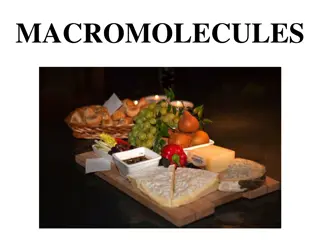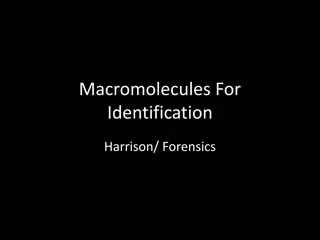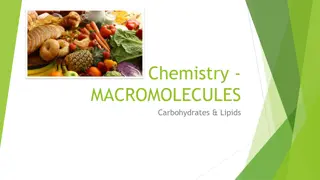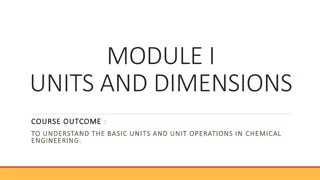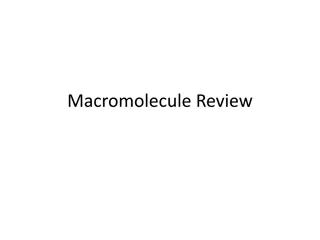Understanding Chemical Groups and Macromolecules in Biological Processes
In biological processes, certain chemical groups play crucial roles in molecular functions. These functional groups, including hydroxyl, carbonyl, carboxyl, amino, sulfhydryl, phosphate, and methyl, are essential for the structure and function of biological molecules. Additionally, macromolecules, such as carbohydrates, proteins, and nucleic acids, are polymers made up of monomers linked through covalent bonding. Understanding these chemical groups and macromolecules is key to comprehending the molecular mechanisms driving life processes.
Download Presentation

Please find below an Image/Link to download the presentation.
The content on the website is provided AS IS for your information and personal use only. It may not be sold, licensed, or shared on other websites without obtaining consent from the author. Download presentation by click this link. If you encounter any issues during the download, it is possible that the publisher has removed the file from their server.
E N D
Presentation Transcript
4.3 A small number of chemical groups are key to the functioning of biological molecules Chemical groups can sometimes affect molecular function by being directly involved in chemical reactions; these types of groups are known as functional groups. There are 7different chemical groups that are most important in life s biological processes: Hydroxyl Carbonyl Carboxyl Amino Sulfhydryl Phosphate Methyl
A hydroxyl group consists of a hydrogen atom bonded to an oxygen atom, which then in turn is bonded to the carbon skeleton of an organic molecule. Example: Ethanol A carbonyl group consists of a carbon atom joined to an oxygen atom by a double bond. Example: Acetone
A carboxyl group consists of an oxygen atom double bonded to a carbon atom which is also bonded to an OH group. Example: Acetic Acid An Amino group consists of a nitrogen atom bonded to two hydrogen atoms and the carbon skeleton of the organic molecule. Example: Glycine
A sulfhydral group consists of a sulfur atom bonded with a hydrogen atom Example: Cysteine A phosphate group consists of a phosphorous atom bonded to four oxygen atoms. One oxygen is bonded to the carbon skeleton, two carry a negative charge, and the final one is double bonded to the phosphorous. Example: Glycerol Phosphate
A methyl group consists of a carbon bonded to three hydrogen atoms. Example: 5-Methyl Cytidine
Adenosine triphosphate(ATP) has an important function within cells. This organic compound undergoes a chemical reaction that causes the compound to lose a phosphate molecule. This breaking of the bond releases energy for the cell to use.
5.1 Macromolecules are polymers, built from monomers Macromolecules are giant molecules that are formed through the joining of smaller molecules. Examples: Carbohydrates Proteins Nucleic Acids A polymer is a long molecule that consists of similar/identical blocks that are linked together through covalent bonding. (The same way that a train consists of a line of cars.) The building blocks of polymers are small, repeating molecules called monomers.
Monomers are bonded together through the loss of a water molecule in what is known as a condensation/dehydration reaction. This reaction pattern can be repeated multiple times by chaining the monomers together and building a polymer. This dehydration process that takes place is regulated by enzymes, which are specialized macromolecules that speed up chemical reactions within cells.
Hydrolysis is a process that is essentially the reverse of a dehydration reaction. Hydrolysis occurs when water is added to a compound in order to break a bond.












